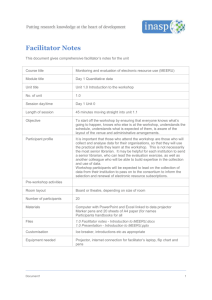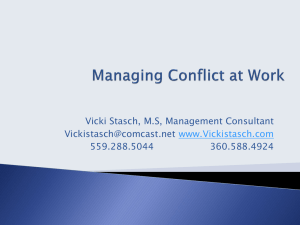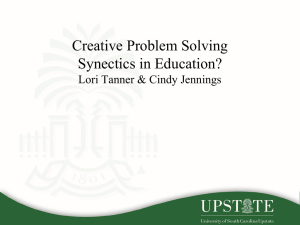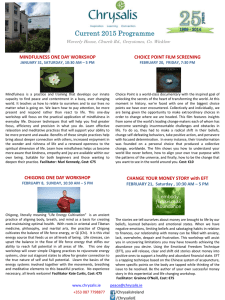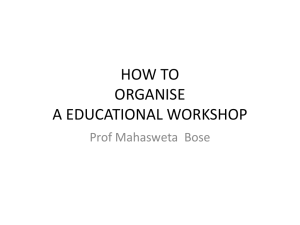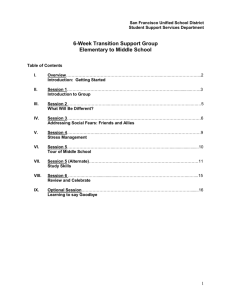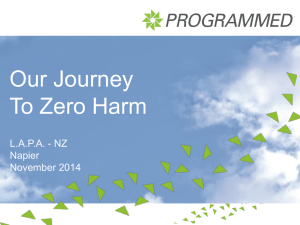Brainstorming
advertisement
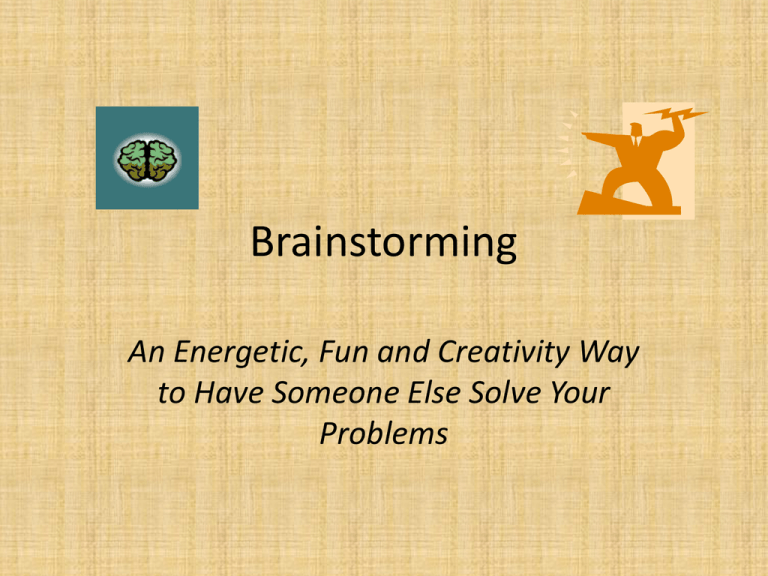
Brainstorming An Energetic, Fun and Creativity Way to Have Someone Else Solve Your Problems When to Use Brainstorming • When you are looking for a wide variety of ideas • Looking beyond the borders that you may have set consciously or unconsciously • You want ideas from a number of individuals What is Brainstorming • Formally developed in 1930 by Alex Osborn – Since that time, 46 (or more) types • Looking for a way to stimulate small groups of knowledgeable, industry-savvy individuals to solve problems – Interactive Techniques – Trigger Method, SIL Method and Wildest Idea • Less than 10 participants, plentiful time, no differences in status of participants and discussion is deemed useful – Parallell – Brainwriting Pool, Method 6-3-5, Pins-Cards, Gallery Method, Crawford Slip, Nominal Group • Larger groups, limited time, differences in status, need a lot of ideas Trigger Method from Ford Motor Company • • • • • • • The problem statement is read to the team Each member spends five minutes writing down his first reactions to solving the problem At the end of this silent idea-generation period, one participant reads one of her ideas to the group For 10 minutes the group discusses but does not evaluate the idea—a tricky distinction. The goal is to use the idea as a springboard for variations and other ideas This routine continues until all the ideas of all the team members have been read aloud and batted about The new ideas and variations can then be used for yet another session, or an evaluation and recommendation phase can begin VanGundy notes an interesting variation to the Trigger Method. If the team is large, it can be split in half. Half of the team conducts the Trigger session as just described. The other half "fish bowls" or surrounds and observes the proceedings. The observers write down any ideas that come to mind while listening to the discussion. These ideas are added to the discussion once the group exhausts the ideas from the original silent-generation round SIL Method (Successive Integration of Problem Elements) • A group of four to seven participants generates written solutions to the stated problem • Two participants each read one of their ideas to the team • The team discusses ways to integrate the two ideas into one solution • A third participant reads an idea to the group and--you guessed it--the group tries to mold these three ideas into one possible Solution • This "add-an-idea" cycle continues until all the ideas of all the participants have been read aloud, and the group has tried to integrate them • The process is complete when the group reaches consensus on one integrated solution Just try to get consensus with these ideas within a reasonable period of time! Brainwriting • Five to eight people are seated around a table • The facilitator presents a problem to the group • The participants write their ideas on a sheet of paper or a large note card • When a participant has written four ideas, he places his idea sheet in the middle of the table (the pool) in exchange for another participant's sheet • Participants read the ideas on the new sheet and then add ideas of their own. They may return the sheet or card to the pool and draw out a different sheet whenever they need additional inspiration • After 30 to 40 minutes, the process ends, the idea sheets are collected, and an evaluation phase begins 6 - 5 - 3 • • • • • • • Six participants have Five minutes to write down Three ideas Sheets are then passed to person on the left 6 - 5 - 3 again adding to the ideas listed Passed to left 6 - 5 - 3 again until sheet gets back to originator • Ideas then are discussed and voted on Pin - Cards • Problem statement written on board • Each participant gets stack of colored cards • Write down one idea per note card, as many cards as you can • Lay the cards down by the person on your left • That person reads the cards when they are short of ideas. They add ideas to the card they picked up • Sort ideas and select Crawford Slip Method • Motivational orientation. The facilitator explains why this process is being used, emphasizes the importance of the participants' insights into the problems to be solved, and assures participants that as far as the full group is concerned, their ideas will be anonymous. • Directions about slips. Twenty-five 3-inch by 5-inch slips of paper are distributed to each participant. The facilitator emphasizes that each slip is to be used for only one idea, consisting of a single sentence. The sentence is to be written across the top edge of the slip. If an idea needs more explanation, participants are instructed to use separate slips for each sentence. • Present the target. "Target" is Crawfordese for the problem to be solved. The facilitator usually, but not always, presents targets one at a time, although several targets may be worked on in the same session. Warm up before the "buzz." Participants are given 20 minutes to write solutions to the target problem. • Buzz group formation and conduct. If the group is large, it is broken into three-person units, with each unit separated physically. There is no leader, and no notes are to be taken. Each person presents one thought or idea from his slips. This round-robin continues until all the warm-up ideas have been read aloud. Then there is a free-for-all discussion, the time limit depending on the number of targets being worked on. Break-out groups tackle targets one at a time. • Sum-up or consolidation. Participants return to working alone. Again, using the slips, each participant writes a recommendation for solving the target problem on one slip. Participants can write as many slips as necessary to record their best ideas. Both "sum-up" and "warm-up" slips are turned in to the facilitator. Time limit for the sum-up is five to 10 minutes per target. • Evaluation. The team leader or facilitator may do the evaluation alone or together with a small group from the workshop. The slips are sorted into categories of similar ideas and titled in a descriptive manner. When all thoughts and ideas have been categorized, they are ranked and evaluated for their relevance to the problem. Ideas that survive the cut are included in a report on possible solutions, written by the facilitator or the small group. Necessary Agreements • When criticism shows up, willingness to risk goes away, so does creativity • There are no bad ideas – none – nada • ANY reaction to an idea can thwart more ideas – No “Good idea”, “What?” or anything • More ideas generate more ideas • Stretch the envelope – stimulates ideas and lets others know that it is OK to risk • Write down ideas as close to what is said as possible – – Sometimes use facilitator and a scribe Needs • • • • • • • 8-14 participants Quiet undisturbed location 2-3 hours Flip chart paper Different colored markers Tape or self adhesive Facilitator – possibly a scribe as well Nominal Group – Idea Generation • • • • • • Start with a focus statement – How – What Silent generation – 7-10 minutes Arrange in a circle Pick someone to start Go around circle – 1 idea per person per round Facilitator can participate • REALLLY wild ideas! Open the group up • Encourage everyone to keep writing down ideas • If someone is out of ideas, encourage them to keep thinking – it is OK to pass • Keep going until no more ideas surface Nominal Group - Consolidation • Give yourself a round of applause • Combine like ideas – Get agreement from contributors – “Cluster” ideas • Have participants vote on ideas – How many ideas do you want to focus on? 5? 10? • Scoring – top idea gets 5 points – second gets 4 – third gets 3 – fourth gets 2 – fifth gets 1 • Participants get up and walk around posted flip charts and score ideas • Add up points to get winner Nominal Group - Implementation • Whatever is the top idea, DO IT – Reinforce the process • Publicize ideas – Get more people thinking – continuous improvement • Celebrate process • Encourage more participation Brainstorming • Try it soon – Perfect practice makes perfect • If you need help, give me a call – Steve Hinds – 6-1425 – Ansph1


